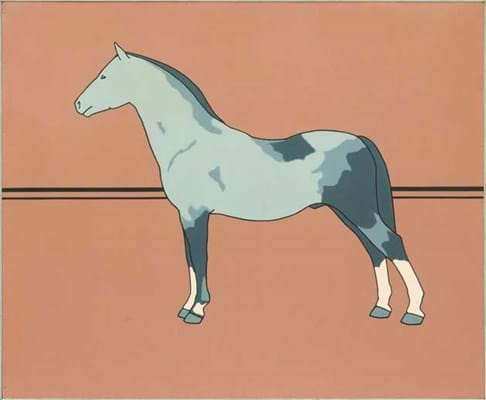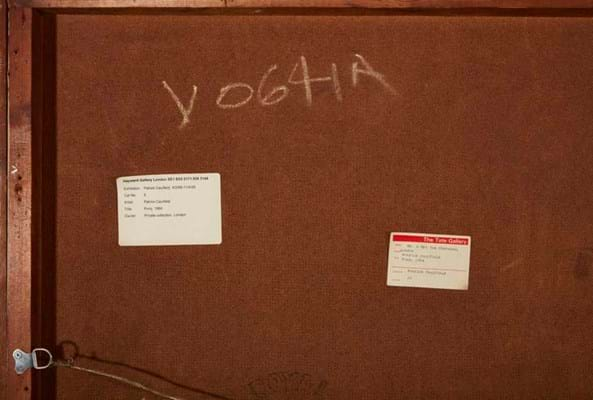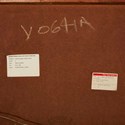The oil on board - as the name suggests, a depiction of a horse - is by British artist Patrick Caulfield and is guided at £300,000-500,000 at the September 26 sale held at the West Norwood saleroom.
It comes from a key period in the artist’s career and is being offered for sale for the first time on the open market since its original purchase directly from the artist in the year of its conception.
Pony also boasts an excellent provenance. It was on loan to the Tate gallery in 1981 for inclusion in the artist’s first major retrospective entitled 48 Paintings from 1963-81, and was also included in the artist’s third retrospective exhibition in 1999 comprising 55 paintings from the years 1961-97 at The Hayward Gallery.
Apart from these public appearances the painting has remained in the same family’s possession since 1964, having been purchased then by Mr and Mrs Tom Chetwynd; then by descent. The Chetwynds were friends of Caulfield and they purchased this work alongside Still Life with a Dagger (1963), now held by the Tate in London.
Challenging the viewer
At the time it was painted a broad revolution in the art world was taking place with the emergence of the Pop Art scene. However, Caulfield, who may on the surface be considered as one of the leaders of that movement, did not categorise himself as that.
Roseberys director Marcus Grey says: “The artist viewed himself as a formal painter using simple objects from everyday life to create timeless views often tainted with a subtle amount of irony. Where Pop Art focused on the throwaway culture of consumerism, Caulfield was looking to challenge himself and the viewer by presenting often traditional, romanticised subject matter that many other modern artists of the time shied away from.
“It could in fact be argued the stylised line, bold colours and flattened surface areas in his works are almost the only crossover between Pop Art and his work.”
Caulfield studied at the Chelsea School of Art, and then at the Royal College of Art, where his contemporaries included David Hockney, Allen Jones and Ronald Brooks Kitaj. While these artists were looking at consumerism and the future, Caulfield was more interested in referencing art history, tradition and structure.
Household paint
On initial inspection, Pony, which is painted on board in household oil-based paint and measures 4 x 5ft (1.22 x 1.53m), may appear to be a painting which can be commonly associated with the mannerisms of the Pop Movement. A closer look reveals a painting “laced with historical reference and elegant structure”.
Grey adds: “The work is a pared-down depiction of a horse – at first glance without obvious historical references or context. On closer inspection though, it can be interpreted as a camouflaged reference towards 18th and 19th century equestrian paintings – especially the works of George Stubbs. Caulfield is quoted as being interested in this subject because ‘the Englishman’s favourite paintings are of horses’.”
The bold horizontal lines in the background echo the position of the horizon often seen in such paintings.
“However, in stark contrast to the silken stallions in Stubbs' work, Pony is a masterclass in stripping back the shape and form of the horse and unlike his contemporaries who were working with spray paint, rollers and stencils Caulfield chose the traditional tool of the brush and painstakingly painted the surface to achieve a flattened image,” says Grey.
“Perhaps more interesting than the subject matter is the distinct reference in this piece to the Minoan frescoes in Knossos, Crete. Caulfield visited Greece twice before this painting was produced, and with this in mind it becomes immediately apparent that the dusty pinks, minimal lines, flattened forms and decorative black bar framing the work drawer direct influences from the Throne Room in the Minoan ruins.”
Caulfield at auction
Recent auction results for Caulfield, together with the early date of 1964, underpin the hefty estimate at Roseberys.
According to the Art Sales Index, Caulfield’s Foyer, 1973, sold for a premium-inclusive £665,000 as part of the David Bowie sale at Sotheby’s in November 2016.
Sun lounge, 1975, sold for a hammer price of £450,000 at Christie’s in June 2006 – a picture resold by Christie’s in November 2011 for a similar sum.
Meanwhile, at Sotheby's in October last year as part of the Howard Hodgkin collection, Caulfield’s Sweet Bowl, an oil on board from 1966, sold for £430,000 hammer.
Pony preview
Roseberys will be holding a preview event including the Caulfield and selected highlights from the Modern & Contemporary British Art auction at High Clothing Store, 16-17 Hay Hill, London, W1J 8NY, on September 11-13, from 10am-6pm, in addition to the firm’s standard viewing times.









